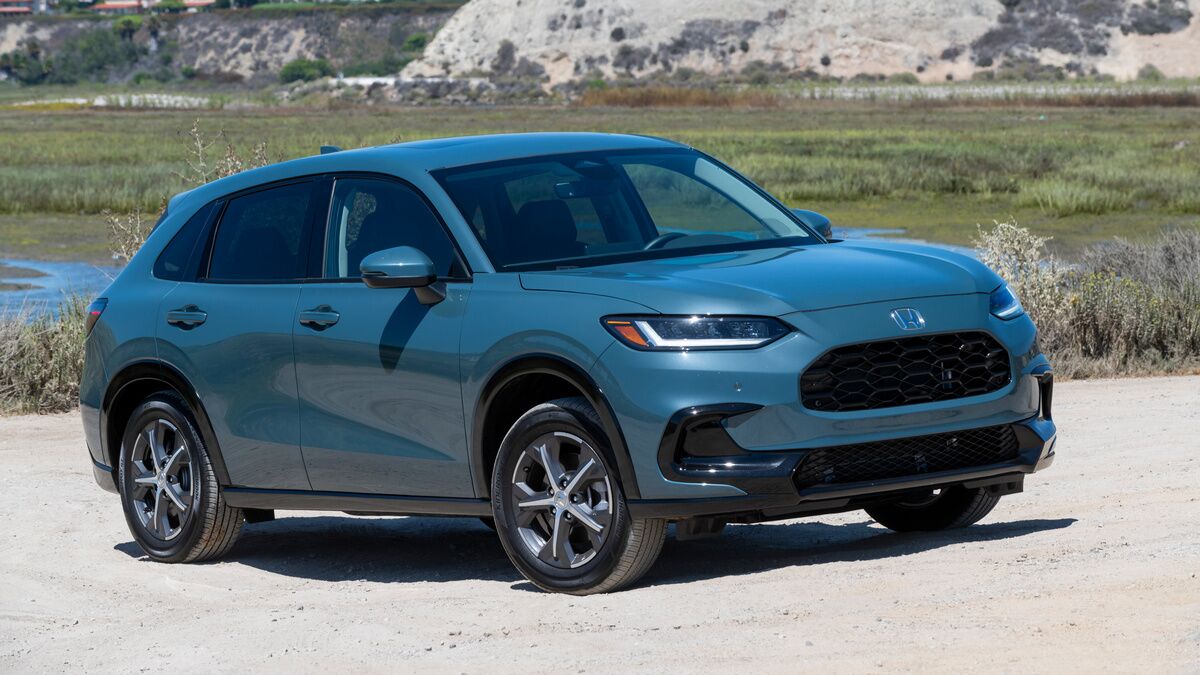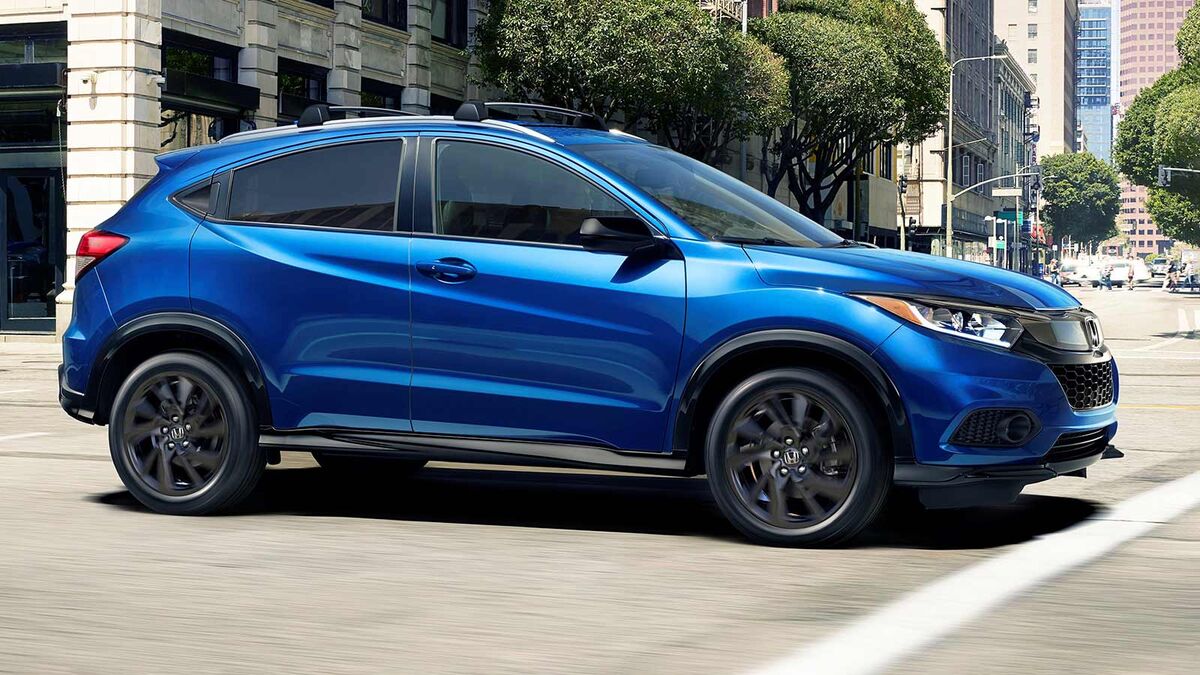Used Honda HR-V Quick Facts
- The first HR-V debuted in Japan in 1998, but didn’t arrive here until 2015.
- Early front-drive HR-V models offered the option of a manual transmission.
- The 2016 HR-V was the first choice of first-time and Gen Z subcompact SUV buyers.
The Honda HR-V is a great choice for city commuters and first-time used car buyers who need a compact crossover that is good on gas, has a versatile interior, has an excellent reliability record, and has a strong resale value. While the HR-V isn’t big on power, it can scoot along with traffic just fine. The HR-V makes year-round transport when fitted with all-wheel drive (AWD). On the first-generation, Honda’s clever Magic Seat allows oversized items to fit in a little space, and on the second-generation models, advanced driver assistance helps avoid accidents and makes driving long distances a little less taxing.
- What Is the Best Model-Year Used Honda HR-V?
- Honda HR-V by Generation: Which Should You Buy?
- Is the Honda HR-V a Good SUV?
- Does the Honda HR-V Offer a Hybrid or Electric Option?
- How Much Can the Honda HR-V Tow?
- What Are the Most Reliable Years for the Honda HR-V?
- What Are the Worst Years for the Honda HR-V?
What Is the Best Model-Year Used Honda HR-V?
For its combination of value, features, and advanced driving assists, we’d go with a 2020-2022 HR-V. If your budget is more generous, a second-generation 2023 or 2024 offers more room, more power, better handling, and a more up-to-date infotainment setup.
See used Honda HR-V SUVs near you.
Honda HR-V by Generation: Which Should You Buy?
Second Generation: 2023-Current

The second-generation HR-V debuted in 2023. It marks a substantial change for little Honda, which adopts the Honda Civic platform as its basis. Larger and more powerful than the first-generation HR-V, the second-gen offers less interior space, most notably in the rear seat and cargo area. It also loses the first generation’s versatile Magic Seat. Still, when compared with others in this class, the HR-V remains near the top regarding interior comfort and convenience.
A single engine covers all three trim levels (LX, Sport, and EX-L). It’s a 2.0-liter 4-cylinder making 158 horsepower. A continuously variable automatic transmission (CVT) is the only transmission choice, but you can opt for front-wheel drive (FWD) or all-wheel drive. Fuel economy figures are good, but not hybrid-like, earning 26 mpg city and 32 mpg highway. All-wheel-drive models rate slightly lower at 25 mpg city/30 mpg highway.
Honda upgrades the HR-V’s rear suspension, changing it from a torsion beam rear axle to a multilink design that greatly improves the HR-V’s cornering and riding. Also standard are hill descent control, hill start assist, and an electric parking brake with a hold function.
The base LX includes such standard features as 17-inch alloy wheels, LED headlights, single-zone automatic climate control, and an infotainment system with a 7-inch touchscreen, Apple CarPlay, and Android Auto.
Honda Sensing driver assistance features also come standard. These include forward collision warning with emergency braking, lane departure/lane-keeping assist, adaptive cruise control with low-speed follow, Traffic Jam Assist, traffic sign recognition, and automatic high beam headlights.
We would choose the Sport. It adds 18-inch alloy wheels, a blind-spot monitor, rear cross-traffic detection, heated front seats, a leather-wrapped steering wheel, two additional speakers, and proximity keyless entry with Walk Away Auto Lock.
The EX-L is the fancy HR-V. It adds an 8-way power driver’s seat, leather upholstery, 17-inch wheels, low-speed brake control, front and rear parking sensors, a power moonroof, ambient interior lighting, a wireless charging pad, and a 9-inch touchscreen hosting turn-by-turn directions, wireless Android Auto/Apple CarPlay, satellite radio, and an 8-speaker 180-watt audio system.
Honda has resolved many of the first-generation issues, especially regarding the CVT. Of the few complaints we found for the second-gen HR-V, the most prominent dealt with glitches in the adaptive cruise control, some electrical issues with the touchscreen, and rear liftback windows that shatter. There are also recalls for the fuel pump, seatbelt anchors, and difficulty steering due to steering gearbox damage. You can see a complete list of HR-V recalls and complaints by visiting the National Highway Traffic Safety Administration website.
Model-Year Changes:
2025: No significant changes.
2024: No significant changes.
See 2023 to current Honda HR-V SUVs near you.
First Generation: 2016-2022

The first-generation HR-V splits into two camps. From 2016 through 2018, the HR-V remained a pretty basic SUV that lacked upscale features, advanced driver aids, and tech. However, these are the only model years in which the HR-V offered a manual transmission, which is preferable to the CVT, which proved problematic during this time. Upgrades made to the 2019 model improved the cabin, infotainment, CVT, and paint quality. These years also feature Honda Sensing driver aids, like automatic emergency braking and adaptive cruise control.
Another unique feature for the first-generation HR-V is the rear Magic Seat. Simply put, it’s a rear seat that allows the seat cushion to flip up and lock in place, opening the entire rear floor for storage and making fitting tall items (think a potted plant) much easier to haul.
The trim lineup for this generation includes the LX, EX, and EX-L w/Navigation. All feature a 148 hp 1.8-liter 4-cylinder paired with either the aforementioned 6-speed manual (FWD-only) or CVT. All three trims offer all-wheel drive.
The LX features 17-inch alloy wheels, auto-off headlights, air conditioning, power windows, power locks, power mirrors, cruise control, a 160-watt 4-speaker audio system with CD, Bluetooth, and automatic brake hold.
The EX adds a 180-watt 6-speaker audio system with 7-inch display audio touchscreen, a power moonroof, Smart Entry proximity keyless entry and push-button start, auto headlights, fog lights, heated side mirrors, variable wipers, automatic climate control, heated front seats, and Honda Lane Watch featuring an integrated camera in the passenger side mirror that shows an image of the adjacent lane when using the turn signal.
The EX-L with Navigation brings navigation, leather upholstery, satellite radio and HD Radio, and roof rails.
The Sport and Touring trims arrive after 2019. The Touring adds standard all-wheel drive, LED headlights, navigation, and an 8-way power driver’s seat.
In this generation, the CVT experiences shuddering, slow response, and even failure. Honda addressed most issues after the 2019 makeover, but some still persist. Other issues include AC compressor failure, a parasitic drain leading to a dead battery, some electrical issues with the touchscreen resetting or freezing up, paint that easily chips or peels, and rear liftgates that freeze shut in extremely cold weather.
Model-Year Changes:
2022: No significant changes.
2021: Sport trims get new wheels and rear privacy glass.
2020: No significant changes.
2019: The HR-V gets a major upgrade, with new styling, two new trims (Sport and Touring), and new audio systems. Honda Sensing is available on all trims (standard on EX and higher), while EX and higher trims gain Apple CarPlay and Android Auto integration. Navigation moves from the EX-L to the Touring, and the manual transmission option gets dropped.
2018: Other than some new colors and wheels, no changes.
2017: No significant changes.
See 2016 to 2022 Honda HR-V SUVs near you.
Is the Honda HR-V a Good SUV?
Overall, the HR-V is a good choice as a used vehicle. It delivers good fuel economy, a roomy cabin, good resale figures, and a fairly good track record for reliability, except for some issues with early CVTs and touchscreen infotainment systems.
Does the Honda HR-V Have a Hybrid or Electric Option?
There are no hybrid or plug-in hybrid electric vehicle (PHEV) options for the HR-V.
How Much Can the Honda HR-V Tow?
Honda does not recommend towing with your HR-V. However, the HR-V can be fitted with a rear hitch for bicycle or ski attachment use.
What are the Most Reliable Years for the Honda HR-V?
The 2023 and newer models are the most reliable. For the first generation, we’d choose the 2020 through 2022 HR-V.
What are the Worst Years for the Honda HR-V?
The HR-V’s years we’d be cautious around are the 2016 through 2018 models equipped with the CVT. First-generation models have issues with the AC compressor, fuel pump, shattering rear glass, glitchy touchscreens, and a few recalls mentioned above.











